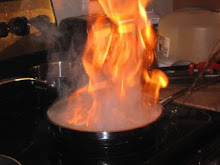When I first started writing this blog, I was really only interested in having some tasty meals now and again. But somewhere along the way, that mild interest and talent turned into something to study--to understand from beginning to end. A real thirst to read and learn everything I can get my hands on.
This thirst has taken me to all sorts of new cooking techniques, from cooking my steaks by basting them in smoking hot clarified butter to using a chinois to strain my soups and stocks to tying bouquet garnis and sachet d'epices. At times I have become obsessed with classic sauces, and I've even had a bit of success; I'm pretty proud of my ability to make a good gastrique or a flavorful coulis. But my success with sauces is limited by my success with an even more basic building block of fine cuisine.
Making your own stocks allows you to avoid spending $4 on these guys' oversalted version (510 mg/serving!!!) in addition to controlling the flavor profiles. And having plenty of chicken stock on hand gives you an ingredient essential to make a consommé, a velouté, or any one of a number of other white sauce derivatives. Beef or veal stock lets you make brown sauces like the classic demi-glace or espagnole (a sauce that apparently dates back to the 19th century).
But for this winter weekend I was simply content to let my chicken stock be the base for a rich, earthy parsnip and celery root soup. I blame my obsession with creating the perfect parsnip soup on the exceptional soup sometimes offered by my oft-mentioned favorite restaurant Corduroy, and I was determined to do all the right things with this latest attempt. And boy did it pay off.
Not only was I incredibly careful to let neither the stock nor the eventual soup boil, but I actually did my due diligence and skimmed away the impurities that rise to the top during the simmering process. Usually this step falls victim to lazy ambivalence, but fellow Emory Grad Lauren had strep throat and she deserved the best, darnit. So there was the skimming, the use of a bouquet garni to have full control over how long my spices infused into the soup, and finally another basic building block of classical french cooking: a roux.
A roux is simply three parts flour to two parts fat, cooked over medium heat until it combines. Lighter roux (white or blond) have mild flavors but do well to thicken sauces or soups. Darker roux (brown or dark brown) have strong toasted or nutty flavors (dark roux is an essential ingredient in good gumbo) but don't have as much thickening power as the lighter roux.
I chose to cook my roux until it was brown, sacrificing a bit of the thickening power for the flavor. It did every bit the job it was supposed to: thickened my soup without a need for heavy cream. Score.
I finished the soup with just a sprinkling of cayenne, paprika, and thyme. In the future, I'd prefer a full sprig of fresh thyme, but I had to use the rubbed thyme I had on hand. I've also got to find a way to cut the richness of this soup. It's good...very good...but has so much intense earth flavor that a bit of acid (maybe some lemon oil?) or sweetness from a butternut squash coulis (successful in the past) could provide a little break.


2 comments
i thought this blog was going to be about food and politics.
March 6, 2009 at 9:20 PMthis dish has been confirmed as elitist
settle down.
March 7, 2009 at 9:55 PMalso, this entire blog is elitist.
which actually brings me to my next post....
Post a Comment